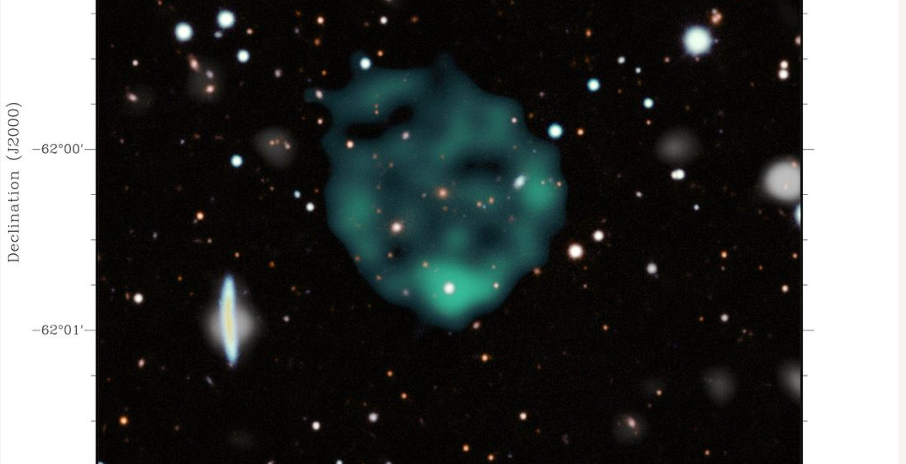The recently discovered class of objects known as Odd Radio Circles (ORCs) has a new member: This one is fainter and smaller than previous discoveries and was only detected using an intense study of a small area of the sky. This leads the team responsible to suspect there are many similar examples waiting to be discovered when similar approaches are conducted elsewhere.
A new era in radio telescope capacity has led to the discovery of several new sorts of astronomical objects that had never been seen before. In each case, astronomers were initially baffled by the findings, leading some to be given names that indicate that bewilderment – for example, Odd Radio Circles originally having been nicknamed WTFs. The source of at least one member of one of these categories – long-period radio transients – was revealed last month, but that’s just the start of working out how they are made.
ORCs were first announced in 2020, and had astronomers so puzzled they initially suspected equipment error. As the name suggests, they form large, almost perfectly circular areas of the sky from which radio signals are received unlike anything seen before.
The most astonishing thing about ORCs is their size. When first discovered, astronomers could not tell if they were moderate-sized objects relatively close to us, or gigantic ones further away. Now, however, we know there are galaxies or active galactic nuclei at the heart of each. Measuring the distances to these galaxies revealed the first five ORCs to be discovered are 1-1.5 million lightyears across, a mind-bending size even for astronomers used to working on galactic scales.
The latest discovery, known as ORC J0219–0505, has a diameter of around 370,000 light-years, which would be enormous by any standards other than the previous members of the group. For example, it’s more than twice the size of the galaxy at the circle’s center, which is of similar size to our own Milky Way.
Professor Ray Norris of CSIRO led both the original ORC discovery and the new one. However, he explained to IFLScience that, at this point, knowledge of its nature is sparse.
All ORCs are known to be rapidly expanding, so a smaller object might be a younger one. However, Norris told IFLScience he has “No idea,” if this is the case. “It could also be about the medium it is expanding into,” he explained. A slightly less complete vacuum between galaxies might restrict the ORC’s expansion. Similarly, Norris said, the team can’t say why this ORC is fainter than all the others.
Although they appear circular in two dimensions, we now know that ORCs are spheres surrounding central galaxies, created by some sort of shock around a billion years ago.

The original ORC, looking very similar.
Image Credit: Norris et al/Publications of the Astronomical Society of Australia, Courtesy of Ray Norris.
Several competing explanations for this shock exist, including that it is created by the merging of either supermassive black holes or entire galaxies, or the collective actions of many supernovae blasting vast quantities of gas out of their galaxies. In the last case, electrons stripped from the gas are much lighter and therefore travel further than the gas itself, and could be producing the radio waves while invisible to us by other means.
Norris told IFLScience he previously favored the merging black holes explanation, “But the offset between the center of ORC J0219–0505’s sphere and the supermassive black hole is difficult to account for.” On that basis, Norris thinks collisions between gas clouds during galactic mergers are probably the front-runner. These collisions are thought to create shockwaves that accelerate electrons beyond the merged galaxy, but Norris considers the issue still wide open.
ORC J0219–0505 was found as part of a 564.2-hour study by the MeerKAT radio telescope of a 20 degree2 area of the sky. Since something this faint would probably not have been detected without such an in-depth survey by an instrument like MeerKAT, the authors expect similar objects are waiting to be discovered once the rest of the sky gets similar attention.
Norris told IFLScience that the most significant part of the discovery is that all previous ORCs are very similar in size, brightness, distance, and age. This led astronomers to wonder if something was special about these conditions, or if the similarity reflected selection bias from the methods used to find them. Adding something significantly smaller and fainter to the mix makes it likely we’ll spot plenty of smaller ORCs (goblins, perhaps?) once suitable techniques are expanded, and there may be other subgroups to come as well.
The paper has been accepted for publication in Monthly Notices of the Royal Astronomical Society, and is posted as a preprint on ArXiv.org.
[H/T Phys.org]
Source Link: Newly Discovered Odd Radio Circle Indicates A Smaller Subtype Exists